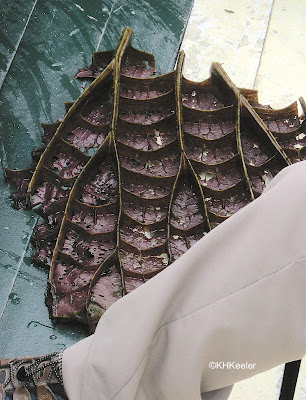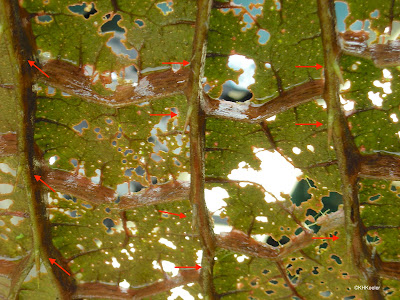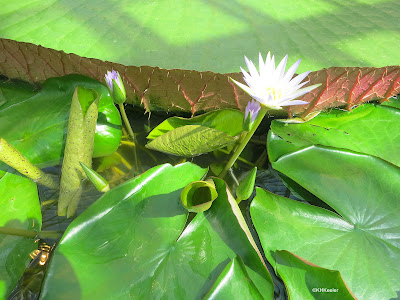The Victoria water-lily (Victoria amazonica) is a grand plant with 8' diameter leaves and big fragrant white flowers. It caused a stir when it was discovered and the English made it a symbol of Queen Victoria. It made another stir last week when a new publication recognized a giant water-lily in the same genus, Victoria boliviana, with 10' diameter leaves. (Description of discovery and the July 4, 2022 recognition of a third species in the genus Victoria in the previous post: link).
But beyond all that, it is an amazing plant.
 |
| Victoria water-lilies, Urucayli River, eastern Peru the white blob in the center is a flower |
Victoria is a water-lily that grows rooted in the mud of ponds and slow-moving rivers in tropical South America. It has a spectacular growth rate, the leaves can expand 20" in a day. The regions where Victoria waterlilies grow are characterized by dramatic changes in water level. They fill to 15' deep or more at the peak of the wet season, then drain to mud flats in the dry season. Victoria water-lilies rise with the water, so the stem below the leaf can be 25' long. While they can live more that a year, mostly they don't, growing from a seed as the water arrives, expanding across great areas at high water, then dying when the water is gone.
Victoria water-lilies are "thugs," my current word for plants that aggressively crowd out other plants. Those big leaves roll over lesser plants as they expand, covering them. In the photo below, you can see the great plate-like Victoria leaf stabbing and crushing the water-lily (Nymphaea) leaves beside it. Under the Victoria leaves, there is such deep shade other plants cannot grow.
 |
| leaf turned over to show structure |
 |
| Closer look at leaf from underneath. Red arrows point to prickles all along the ribs. |
The flower buds stay under water until they are ready to bloom, then emerge in the night, releasing a lovely scent. The scent attracts beetles, which climb into the flower and are trapped there until the second night when they are released to carry pollen to another flower. For Victoria amazonica, generally the first night the flower is white, the second night deep red.
 |
| Bud of Victoria amazonica breaking through an old leaf |
 |
| open flower, Victoria amazonica, Urucayli River, Peru |
The pollinated flower drops below the water surface and seeds develop quickly. When ripe, the fruit opens, setting the seeds adrift. The seeds are encased in muscilage. They float away, to be buried in the drying mud until next wet season. Why the muscilage? To float? Many seeds float without it. To taste good to fish? Some plants of the flooded Amazon forests exploit fish to carry their seeds farther. No one knows.
Lots of things are still unknown about these plants. Giant water-lily leaves are too big to fit well into plant presses or into jars of alcohol for preservation. They are very moist and easily rot. Not to mention that the prickles make them tricky to handle without pain. To study Victoria water-lilies in nature, you need a boat, navigating on tropical lakes and rivers where water levels and access change rapidly, inhabited by disease-bearing mosquitoes and big alligators. In fact, two of the common names of the southern giant water-lily, V. cruziana, are poncho del yacaré and yacaré yrupé. Yacaré is the local caiman, Caiman yacare, which can be 10' long. Yrupé or irupé is "plant" in the Guaraní language.
The giant water-lilies are edible. Local people collect the seeds and grind them into a substitute for maize and a source of starch. The rhizomes can be dug up and eaten. The stems (petioles) leading to the leaves are also eaten, despite the prickles. Victoria water-lilies are used in folk medicines, for example to treat inflammation and wounds. None of this has been well-studied.
The plants certainly appealed to people. Ana on Pocketcultures retells the "Legend of the Irupé" from the Guaraní of Paraguay and northern Argentina: a maiden fell in love with the moon. She climbed high places but the moon stayed out of reach. Then she saw it reflected in quiet waters. She dove in, thinking now she could touch it, and drowned. "The god Tupá took pity on the maiden and transformed her into an irupé, whose leaves resembled the lunar disk and look up to the skies in a constant search for her lover." (link) Given that Victoria water-lilies are found from Argentina to British Guiana, there must be many other stories about them.
 |
| Victoria water-lilies in the Amazon |
These leaves are so big that at high water, when they are at their largest, they can be seen on Google Earth. They grow. flower, and disperse in the fantastic flooded forests of South America. They have edible and medicinal uses. Wonderful plants. But thugs too.
See them in botanic gardens all over during the summer. For example, in North America, Chicago Botanic Garden link; Denver Botanic Garden link; Fairchild Tropical Botanic Garden, Miami (link); Houston Botanic Garden link; Longwood Gardens, Pennsylvania link; Missouri Botanic Garden link; Quebec Botanic Garden link; U.S. National Arboretum, Washington, D.C. link; and many more.
Comments and corrections welcome.
References
Ana. Legend of the Irupé. Pocketcultures.com link (Accessed 7/12//22).
Brewer, G. 2022. Uncovering the Giant Waterlily, A botanical wonder of the world. Kew Gardens link (Accessed 7/8/22). Popular article, great photos.
Duke, J. A, and R. Vasquez. 1994. Amazonian Ethnobotanical Dictionary. CRC Press, Boca Raton, Florida.
Holloway, T. 2013. Flower of Empire. An Amazonian Water Lily the Quest to Make it Bloom and the World it Created. Oxford University Press. London.
Knotts, K. and B. Knotts. 2006. Victoria Adventure link (Accessed 7/8/22).
Smith, L. T., C. Magdalena, N.A.S. Przeomaska, O.A. Pérez-Escobar, D. G. Melgar-Gómez, S.Beck, R. Negrão, S. Mian, I. J. Leitch, S. Dodsworth, O. Maurin, G. Ribero-Guardia, C.D. Salazar, G. Gutierrez-Sibauty, A. Antonelli and A.K. Monro 2022. Revised species delimitation in the giant water lily genus Victoria (Nymphaceae) confirms a new species and has implications for conservation. Frontiers of Plant Science. 13: 883151. doi: 10.3389/pls.2922,883151. link This is the technical paper, but it is open access and full of interesting stuff; color photos, maps, comparision charts for the species and much more. (Accessed 7/12/22).
Kathy Keeler, A Wandering Botanist
More at awanderingbotanist.com
Join me on Facebook: https://www.facebook.com/AWanderingBotanist

nice post visit us for dwarf Victoria lily
ReplyDeleteNice post, visit us to learn more about how to plant water lily and explore expert tips.
ReplyDelete